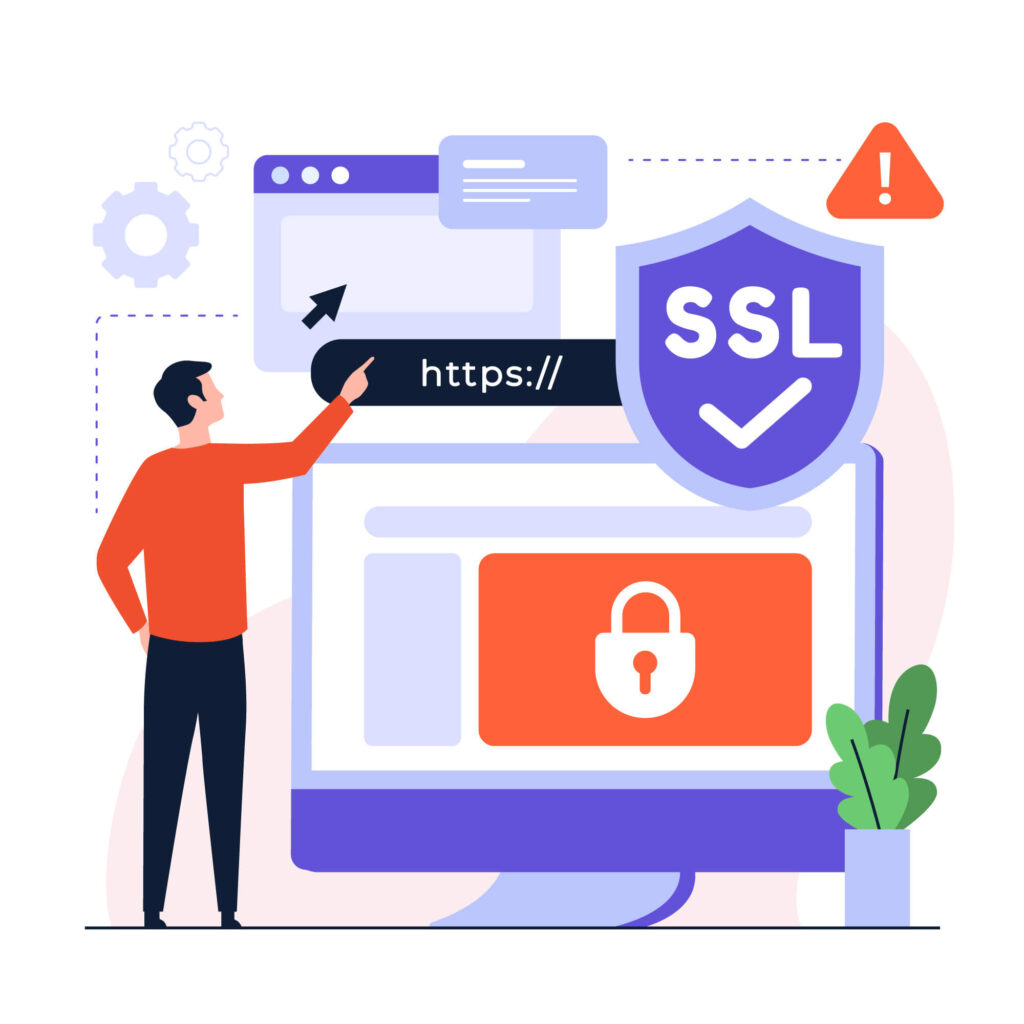A domain name, in the context of the internet, refers to a human-readable web address that is used to identify and access specific resources or websites on the World Wide Web.
It is a crucial part of the internet’s addressing system and plays several important roles:
- Identification: Domains serve as a way to identify websites or resources on the internet. They provide a user-friendly and memorable way to access online content. Instead of typing in a complex IP address (e.g., 192.168.0.1), users can enter a domain name (e.g., example.com) to reach a website.
- Navigation: Domains make it easier for users to navigate the internet. A domain name can represent an entire website or a specific page, making it simple to locate and visit desired online destinations.
- Branding: Domains are an integral part of a brand’s online presence. Businesses and organizations use domains to establish and promote their online identity. A well-chosen domain can enhance brand recognition and trust.
- Email Address: Domains are used for creating custom email addresses. For example, a company might use the domain “example.com” to create email addresses like “info@example.com” or “support@example.com.”
- Online Services: Domains can host various online services and applications, from websites and blogs to e-commerce stores, forums, and web applications. Each of these services can have its own subdomain (e.g., blog.example.com) or use the primary domain.
- Communication: Domains are used in web links and communication. Sharing a domain name is a simple way to direct others to a specific website or resource.
- Global Accessibility: Domains are accessible from anywhere in the world, making the internet a global network. A domain is not tied to a specific geographical location, allowing websites to have a global reach.
- Search Engine Ranking: The choice of a domain name can impact a website’s search engine ranking. Relevant and memorable domain names can make it easier for users to find and remember your website, potentially improving your site’s visibility in search engine results.
The purpose of a domain is to provide a human-friendly and standardized way to access resources and websites on the internet. It simplifies online navigation, branding, communication, and the use of various online services, contributing to the overall functionality and organization of the World Wide Web.
Importance of a domain name
The importance of a domain name for your website cannot be overstated. It plays a crucial role in your online presence and can significantly impact your website’s success.
Here are some of the key reasons why a domain name is important:
- First Impression: Your domain name is often the first thing visitors see. It’s like the digital storefront of your website. A professional and memorable domain name creates a positive first impression, while a poorly chosen one can turn potential visitors away.
- Branding: Your domain name is an essential part of your website development plan and branding. It represents your business or organization and helps in creating a strong online identity. It’s how people will remember and recognize you in the online world.
- Credibility: A custom domain name (e.g., yourbusiness.com) conveys a sense of professionalism and trustworthiness. Visitors are more likely to trust and engage with a website that has its own domain, rather than a generic or free subdomain.
- Search Engine Optimization (SEO): A well-chosen domain name can include relevant keywords, which can positively impact your website’s SEO. Search engines like Google may consider keywords in the domain when ranking search results.
- Memorability: A catchy and easy-to-remember domain name can lead to more returning visitors. People are more likely to recall and revisit a website with a memorable domain.
- Marketing and Promotion: Your domain name is a critical component of your marketing strategy. It can be featured on business cards, advertisements, and other promotional materials. A simple, direct domain makes it easier for people to find you online.
- Consistency: Using a custom domain allows you to have a consistent web address. You won’t be dependent on third-party platforms or subject to changes in their policies or terms of service. This consistency is especially important for businesses and brands.
- Ownership and Control: When you own your domain, you have control over its content and functionality. You can make changes and updates as needed without relying on the policies of a third-party platform.
- Email Credibility: A custom domain name enables you to create professional email addresses (e.g., yourname@yourbusiness.com). This enhances the credibility of your communication with customers, clients, and partners.
- Legal Protection: Registering your domain name can provide legal protection for your brand. It prevents others from using a similar domain that might confuse your audience or infringe on your trademark.
- Global Reach: A domain name allows you to reach a global audience. You’re not restricted by geographical boundaries, and your website can be accessed by people worldwide.
Your domain name is an essential part of your online presence, branding, and success. It’s often the first point of contact with your audience and can influence their perception of your website and business. Careful consideration and selection of a domain name are crucial for building a strong and effective online presence.
II. Understanding Domain Names

A. What is a domain name?
A domain name is a unique, human-readable address that is used to identify and locate websites on the internet. It serves as a user-friendly and memorable way to access websites, and it is a fundamental part of the internet’s addressing system.
A domain name typically consists of two main parts:
- Second-Level Domain (SLD): This is the part of the domain name that you choose for your website. It is usually a name or word that represents your brand, business, or the content of your website. For example, in the domain name “example.com,” “example” is the second-level domain.
- Top-Level Domain (TLD): This is the part of the domain name that comes after the second-level domain. It often indicates the type or category of the website or its purpose. Common TLDs include “.com,” “.org,” “.net,” and country code TLDs like “.uk” for the United Kingdom or “.de” for Germany.
Together, the second-level domain and the top-level domain form a complete domain name, such as “example.com.” Domain names are used to translate human-readable addresses into IP addresses, which are the numerical addresses used by computers and servers to locate each other on the internet.
Domain names are a critical component of the internet’s infrastructure, as they make it easier for users to navigate the web. They also play a significant role in branding, online identity, and the accessibility of websites. When you enter a domain name into a web browser, it sends a request to a domain name system (DNS) server to find the associated IP address and then connects you to the corresponding website. This process happens behind the scenes, allowing users to access websites using simple and memorable names rather than numerical IP addresses.
Learn about the website development cost in India.
C. Domain name extensions and their significance
Domain name extensions, also known as top-level domains (TLDs), are the last part of a domain name, such as “.com,” “.org,” “.net,” and so on. Each TLD has its own significance and purpose, and understanding the differences between them can help you choose the right domain extension for your website. Here’s a breakdown of some common domain extensions and their significance:
- .com (Commercial):
- Significance: Widely considered the most popular and versatile TLD.
- Purpose: Originally intended for commercial entities, but now used for a wide range of websites, including businesses, blogs, e-commerce, and personal sites.
- Advantages: High recognition and trust, good for international sites.
- .org (Organization):
- Significance: Originally intended for non-profit organizations.
- Purpose: Often used by non-profit organizations, but it’s not restricted, and many other types of websites use it.
- Advantages: Conveys a sense of trust and credibility, suitable for various organizations.
- .net (Network):
- Significance: Originally designed for network-related services.
- Purpose: Often used by internet service providers, networking companies, and tech-related sites.
- Advantages: Suitable for network-focused businesses and organizations.
- .gov (Government):
- Significance: Reserved for U.S. federal government websites.
- Purpose: Exclusively for U.S. federal government entities and agencies.
- Advantages: Government authority and trust.
- .edu (Education):
- Significance: Reserved for educational institutions in the United States.
- Purpose: Limited to accredited U.S. educational institutions, such as universities and colleges.
- Advantages: Signifies credibility and authority in the education sector.
- .mil (Military):
- Significance: Reserved for the U.S. military.
- Purpose: Exclusively for U.S. military entities and branches.
- Advantages: Associated with the U.S. military.
- .info (Information):
- Significance: Meant for informational websites.
- Purpose: Used by various websites to provide information, but less common than .com.
- Advantages: Suitable for information-centric sites.
- .co (Country Code):
- Significance: Represents specific countries or territories (e.g., .uk for the United Kingdom, .ca for Canada).
- Purpose: Reserved for entities within the respective country or for businesses targeting a specific region.
- Advantages: Indicates the geographical or regional focus of the website.
- .io (Country Code):
- Significance: Originally the ccTLD (country code top-level domain) for the British Indian Ocean Territory.
- Purpose: Popular among tech startups and the tech community, often used for tech-related websites.
- Advantages: Trendy and popular in the tech industry.
- .app, .blog, .store, etc. (New gTLDs):
- Significance: Part of the new generic top-level domains introduced in recent years.
- Purpose: These new gTLDs offer more specific options for website categorization (e.g., .app for applications, .blog for blogs, .store for e-commerce).
- Advantages: Can help convey the nature or purpose of the website more clearly.
When choosing a domain extension, consider your website’s purpose, target audience, and branding goals. The right TLD can help convey important information about your website and contribute to its recognition and trustworthiness.
III. Choosing the Perfect Domain Name

Choosing the best domain name for your website is a crucial decision, as it can have a significant impact on your online presence, branding, and user experience.
Here are steps to help you select the ideal domain name:
- Define Your Website’s Purpose and Niche:
- Understand the core purpose and content of your website. What will it be about? Who is your target audience?
- Identify the main keywords or key phrases related to your niche. These may help in brainstorming domain name ideas.
- Keep It Short and Simple:
- Short domain names are easier to remember and type.
- Avoid complex or lengthy words, hyphens, or numbers, as they can make your domain name less user-friendly.
- Make It Descriptive:
- Your domain name should give visitors a clear idea of what to expect on your website. It should reflect your content or business.
- Consider Branding:
- If your website is for a business or personal brand, it’s often a good idea to use your brand name as the domain (if available).
- Make sure it’s easy to spell and pronounce.
- Use Keywords Wisely:
- Including relevant keywords in your domain name can improve search engine optimization (SEO). However, don’t overstuff it with keywords; it should still sound natural.
- Avoid exact-match domains that might look spammy.
- Check Domain Availability:
- Before falling in love with a name, check if the domain name is available. You can use domain registration services or domain registrars to verify availability.
- Consider Your Target Audience:
- Think about your ideal website visitors. Does the domain name resonate with them? Is it appealing to your target demographic?
- Avoid Trademark Issues:
- Ensure that your chosen domain name does not infringe on existing trademarks. You can search trademark databases or consult a legal professional if needed.
- Choose the Right Domain Extension:
- Select a top-level domain (TLD) that suits your website’s purpose. Common options include .com, .org, and .net, but there are many new TLDs to choose from.
- Consider using country code TLDs if you have a strong regional focus.
- Think About Future Growth:
- Your website might evolve over time. Ensure that your domain name is broad enough to accommodate potential growth and diversification.
- Check for Similar Domain Names:
- Avoid domain names that sound too similar to existing, well-established websites. You want to stand out, not cause confusion.
- Secure Social Media Handles:
- Consistency is key for branding. Check if your desired domain name is available as a username on major social media platforms.
- Domain Privacy and Security:
- Consider domain privacy protection to keep your personal information safe. It’s a common service offered by registrars.
- Test Its Pronunciation and Spelling:
- Share your domain name with friends or colleagues to ensure it’s easy to pronounce and spell. Avoid homophones and confusing words.
- Avoid Trendy or Dated Terminology:
- What’s trendy today might be outdated tomorrow. Consider the longevity of your domain name.
- Research and Finalize:
- Do thorough research to confirm that your chosen domain name doesn’t have a negative history or associations.
- Once you’ve decided, register your domain name through a reputable domain registrar.
Remember that your domain name is a critical part of your online identity, so choose it carefully. It’s a decision that can have long-term effects on your website’s success and recognition.
IV. Domain Name Registration
Domain name registration is the process of reserving and acquiring a unique and user-friendly domain name for a specific period, typically one year or longer, through a domain registrar or domain registration service provider. When you register a domain name, you essentially purchase the right to use that domain for the duration of the registration period.
Here’s how domain name registration works:
- Choose a Domain Name: First, you decide on the domain name you want to use for your website. This involves selecting a unique combination of letters, numbers, and sometimes hyphens, which will be used to identify your website on the internet.
- Check Domain Availability: Before you can register a domain name, you need to check if the name is available. Domain registrars typically offer search tools on their websites where you can enter your desired domain name to see if it’s already registered by someone else.
- Select a Domain Registrar: To register a domain name, you need to choose a domain registrar, which is a company accredited by the Internet Corporation for Assigned Names and Numbers (ICANN) to sell and manage domain names. Popular domain registrars include GoDaddy, Namecheap, Google Domains, and many others.
- Complete the Registration Process: Once you’ve found an available domain name and selected a domain registrar, you’ll need to provide some personal and contact information, including your name, address, phone number, and email address. This information is used to associate the domain with you as the registrant.
- Choose the Registration Period: You’ll need to select the duration for which you want to register the domain name. Most domain registrars offer options for one year, multiple years, or even several years in advance.
- Additional Services: Some registrars offer additional services, such as domain privacy protection (often called WHOIS privacy), which keeps your personal contact information private and prevents it from being publicly accessible in the WHOIS database.
- Payment: You’ll need to pay the registration fee for the domain name. The cost can vary depending on the domain registrar, the chosen domain extension (TLD), and any additional services you select.
- Confirmation and Ownership: Once you’ve completed the registration process and the payment is processed, you will receive a confirmation that you now own the domain name. You have exclusive rights to use and manage this domain for the registered period.
- Domain Management: After registration, you can access a domain management dashboard provided by your registrar. From there, you can configure DNS settings, update contact information, renew the domain when the registration period is about to expire, and manage other aspects related to the domain.
Domain name registration is a fundamental step in establishing an online presence, whether for a personal blog, business website, or any other web-based project. It’s essential to keep track of your domain’s expiration date and renew it in a timely manner to maintain ownership and prevent it from being released back into the pool of available domain names.
V. Domain Name Best Practices to Buy Domains

When buying domains, it’s important to follow best practices to ensure you make informed decisions and choose the right domains for your needs. Here are some domain name best practices to consider:
- Choose a Reputable Registrar:
- Select a well-established and reputable domain registrar. Some popular registrars include GoDaddy, Namecheap, Google Domains, and others. Research customer reviews and the registrar’s reputation for customer support and reliability.
- Search for Availability:
- Before buying a domain, use the registrar’s search tool to check if your desired domain name is available. You can enter the name and the extension (e.g., .com, .net) to see if it’s already registered.
- Check for Similar or Misspelled Domains:
- Consider buying similar domain names or common misspellings of your primary domain to protect your brand and prevent users from being misled to other websites.
- Use Domain Suggestion Tools:
- Some registrars offer domain suggestion tools that can help you brainstorm ideas and find available domains related to your niche or keywords.
- Consider Your Brand and Niche:
- Choose a domain name that aligns with your brand, business, or website’s niche. It should reflect your identity and purpose.
- Keep It Short and Memorable:
- Shorter domain names are generally easier to remember and type. Aim for brevity and simplicity to enhance user recall.
- Avoid Hyphens and Numbers:
- Hyphens and numbers can make domain names harder to remember and may lead to confusion. Try to stick with letters only.
- Use Keywords Wisely:
- If possible, include relevant keywords in your domain to improve SEO. However, make sure the domain still sounds natural and is not overly keyword-stuffed.
- Consider Alternative TLDs:
- While .com is the most common TLD, there are many other options (e.g., .net, .org, .io, .app, .blog). Consider which TLD best suits your website’s purpose and branding.
- Domain Privacy Protection:
- Consider adding domain privacy protection to your registration. This service hides your personal contact information from the WHOIS database, protecting your privacy.
- Renewal and Expiration:
- Keep track of your domain’s expiration date and ensure timely renewal. Some registrars offer auto-renewal options to prevent accidental expiration.
- Legal Considerations:
- Be aware of trademark and copyright issues. Ensure your domain name does not infringe on existing trademarks or copyrights.
- Manage DNS Records:
- Learn how to configure DNS (Domain Name System) settings to point your domain to the right server or hosting provider. Familiarize yourself with the registrar’s DNS management tools.
- Secure Social Media Handles:
- Consistency in branding is important. Check if your chosen domain name is available as a username on major social media platforms.
- Market Research:
- Research the domain name market. Some domains are bought and sold by domain investors. Understand the market value of a domain before making a purchase.
- Keep Records Secure:
- Safeguard your domain registration credentials, including login information and registrar account details. Losing access to your domain can be problematic.
By following these domain name best practices, you can make well-informed decisions and acquire domains that align with your online goals, brand, and website’s purpose. It’s essential to carefully consider your domain name, as it’s a foundational element of your online identity and presence.
VI. Researching Domain Availability

Researching domain availability is a crucial step when you want to register a domain name for your website. It ensures that the domain name you desire is not already registered by someone else.
Here’s how to research domain availability:
- Use a Domain Registrar’s Search Tool:
- Most domain registrars offer search tools on their websites. Visit a reputable domain registrar’s website (e.g., GoDaddy, Namecheap, Google Domains) and look for their domain search tool.
- Enter Your Desired Domain Name:
- In the search tool, enter the domain name you want to check for availability. Include the desired top-level domain (TLD), such as .com, .net, or others.
- Check Different TLDs:
- If your desired domain name with the .com extension is already taken, consider checking the availability of the same name with other TLDs like .net, .org, .io, or newer domain extensions that may be relevant to your website.
- Review the Search Results:
- The registrar’s search tool will display the results, indicating whether the domain name is available or already registered. If it’s available, you will likely see a message like “This domain is available” or similar.
- Check Variations and Misspellings:
- Consider searching for variations or common misspellings of your desired domain name to protect your brand and ensure users are directed to your website.
- Use WHOIS Lookup:
- You can perform a WHOIS lookup to see detailed information about a domain, including its current owner, registration date, and expiration date. Many registrars and third-party websites offer WHOIS lookup tools.
- Consider Using Domain Suggestion Tools:
- Some registrars provide domain suggestion tools that can help you find available domains related to your niche or keywords. This can be helpful if your preferred domain name is already taken.
- Use Third-Party Domain Search Tools:
- There are various third-party domain search tools and websites that allow you to check domain availability across different registrars. Examples include Name.com, Domain.com, and Instant Domain Search.
- Check Domain Auctions:
- If your desired domain is already registered but you’re interested in acquiring it, check if it’s listed on domain auction platforms like Sedo or Flippa. You might be able to purchase it from the current owner.
- Contact the Domain Owner:
- If the domain you want is taken, and it’s not listed for sale, you can try contacting the owner to inquire about purchasing it. This process is known as domain negotiation.
- Keep a List of Alternatives:
- Maintain a list of alternative domain names in case your first choice is unavailable. This ensures you have backup options to choose from.
Remember that domain availability can change rapidly, so it’s a good practice to check and secure your desired domain as soon as possible once you confirm its availability. Registering the domain promptly helps prevent others from taking it while you make your decision.
VII. Negotiating and Buying an Already Registered Domain
Negotiating and buying an already registered domain name can be a complex process, but it’s often the only way to acquire a domain that’s important for your business or website.
Here are steps and tips for negotiating and purchasing a registered domain:
- Research and Valuation:
- Research the domain thoroughly to determine its value and the current owner’s intent.
- Consider using domain appraisal tools or seeking expert advice for valuation.
- Contact the Domain Owner:
- Look up the WHOIS information for the domain to find contact details for the owner.
- Send a polite and professional email expressing your interest in the domain and your willingness to negotiate.
- Make an Offer:
- When you contact the owner, you may need to make an initial offer to start the negotiation. Be prepared for counteroffers.
- Negotiate Terms:
- Be open to negotiation and flexibility. Discuss terms such as the price, payment method, and any conditions or agreements.
- Keep your budget in mind and be prepared to walk away if the price exceeds what you’re willing to pay.
- Use Escrow Services:
- Consider using an escrow service, such as Escrow.com, to handle the financial transaction. This protects both the buyer and the seller in the transaction.
- Draft a Sales Agreement:
- Once you and the domain owner agree on the terms, draft a sales agreement outlining the conditions and transfer details. It’s recommended to consult with a legal professional to ensure all legal aspects are covered.
- Verify Ownership and Legitimacy:
- Ensure that the person claiming to be the domain owner is indeed the legitimate owner. Scams can occur in domain transactions, so be cautious and verify ownership.
- Secure Payment:
- Use a secure payment method, such as an escrow service, to ensure the transfer of funds and domain happens simultaneously.
- Domain Transfer:
- The domain transfer process involves updating the domain’s registrar and DNS settings. The domain owner will typically provide an authorization code (EPP code) for you to initiate the transfer.
- Confirm Domain Ownership: – Before finalizing the transaction, confirm that the domain ownership has been successfully transferred to your registrar account.
- Update DNS Settings: – Configure the domain’s DNS settings to point to your web hosting provider or desired servers.
- Transfer Ownership with the Registrar: – Work with the domain registrar to complete the transfer and update the WHOIS information with your details as the new owner.
- Document the Sale: – Keep records of all correspondence, agreements, and transaction details for your records.
- Legal Considerations: – Consult with legal professionals if you have concerns about the domain’s history, potential trademark issues, or if the domain’s current owner is not cooperative.
- Be Patient and Persistent: – Negotiating for a domain can be a time-consuming process. Be patient and persistent in your communications, but always maintain professionalism.
It’s essential to approach domain negotiations with care, patience, and a clear understanding of the domain’s value. Keep in mind that not all domain owners may be willing to sell, and some may set a high price. Be prepared to negotiate and be flexible in your approach.
VIII. Managing and Renewing Your Domain
Managing and renewing your domain name is a crucial aspect of maintaining your online presence and ensuring that you continue to own and control your domain.
Here’s a step-by-step guide on how to effectively manage and renew your domain:
- Keep Track of Domain Expiration:
- Always be aware of your domain’s expiration date. You can find this information in your domain registrar’s dashboard or account.
- Set Up Reminders:
- To avoid accidental expiration, set up reminders well in advance of the expiration date. Many domain registrars offer automatic renewal reminders via email.
- Auto-Renewal Option:
- Consider enabling the auto-renewal option provided by your registrar. This ensures your domain is automatically renewed for another year, preventing unintentional lapses.
- Verify and Update Contact Information:
- Ensure that your contact information with the domain registrar is accurate and up to date. This includes your email address, as renewal notifications are sent there.
- Payment Method:
- Ensure your payment method on file with the registrar is valid. If it’s outdated or has changed, update it to prevent issues with renewal.
- Renew in Advance:
- Many registrars allow you to renew your domain well in advance of its expiration date. You can often renew for multiple years. Consider renewing for several years to avoid frequent renewals.
- Grace Periods:
- Familiarize yourself with your registrar’s grace period policy. Most registrars provide a grace period after expiration during which you can still renew the domain, but it may incur additional fees.
- Redemption Period:
- After the grace period, domains typically enter a redemption period. During this time, it may be more difficult and expensive to recover an expired domain.
- Manual Renewal:
- If you prefer not to use auto-renewal, make sure to renew your domain manually before it expires. This can often be done through your registrar’s website.
- Transfer Lock: – If you want to ensure that your domain is not accidentally transferred to another registrar, consider enabling a transfer lock feature provided by your registrar.
- Domain Privacy Protection: – If you have domain privacy protection (WHOIS privacy) enabled, ensure it is also renewed along with your domain registration.
- Backup DNS Settings: – Before renewing your domain, it’s a good practice to have a backup of your DNS settings and configurations, especially if you plan to make any changes or switch web hosting providers during the renewal process.
- Verify Domain Access: – Confirm that you can still access and manage your domain with your registrar before renewal. Check your login credentials and access to your registrar’s dashboard.
- Keep Records: – Maintain a record of domain renewal receipts, confirmations, and any important correspondence related to your domain.
By following these steps and best practices, you can effectively manage and renew your domain, ensuring that your website remains accessible to visitors and that you maintain ownership of your online identity. Domain renewal is a straightforward process as long as you stay organized and proactive.
IX. Protecting Your Domain

Protecting your domain is essential to safeguard your online presence and brand identity.
Here are some steps and strategies to protect your domain:
- Enable Domain Privacy Protection (WHOIS Privacy):
- Most domain registrars offer domain privacy services that mask your personal contact information in the WHOIS database, reducing the risk of spam and identity theft.
- Choose a Reputable Registrar:
- Register your domain with a well-established and reputable domain registrar. This ensures that your domain is managed by a trusted entity with robust security measures.
3. Use Strong Authentication:
- Implement strong, unique passwords for your registrar’s account. Consider using multi-factor authentication (MFA) for an extra layer of security.
- Set Up Domain Locks:
- Many registrars provide domain locking options to prevent unauthorized transfers or changes to your domain settings. Enable these locks to enhance security.
- Regularly Update Contact Information:
- Ensure that your contact information with the registrar is accurate and up to date. This information is used for account recovery and communication.
- Monitor Renewal Notifications:
- Stay vigilant about domain renewal notifications. Renew your domain well in advance of its expiration to prevent accidental lapses.
- Keep Payment Information Secure:
- Protect the payment methods associated with your domain registration account. Verify the legitimacy of financial transactions related to your domain.
- Monitor Your Domain’s WHOIS Records:
- Regularly review the WHOIS records for your domain to ensure that the information is accurate and that no unauthorized changes have occurred.
- Employ a Domain Monitoring Service:
- Consider using a domain monitoring service that alerts you to any changes or unauthorized modifications to your domain settings or WHOIS records.
- Register Variations and Misspellings: – To protect your brand and prevent phishing, consider registering variations of your domain name and common misspellings to prevent misuse by others.
- Regularly Back Up DNS Settings: – Keep backups of your DNS settings and configurations. This ensures you have a copy of your DNS records in case they need to be restored.
- Register Domains for Long Term: – If you intend to keep a domain for a long time, consider registering it for multiple years to minimize the frequency of renewals.
- Renew in Advance: – Renew your domain well in advance to prevent unintentional expiration and the risk of someone else registering it.
- Stay Informed About Domain Security Threats: – Keep up to date with news and information about domain security threats, such as domain hijacking or phishing attacks, to stay vigilant.
- Legal Protection: – Consider trademark registration and legal protection for your domain name to prevent infringement by others.
- Act Promptly on Unauthorized Changes: – If you notice unauthorized changes to your domain, contact your registrar immediately to rectify the situation.
- Professional Advice: – Consult with domain security professionals or legal experts if you have concerns about domain security or if you need assistance in protecting your online assets.
By implementing these strategies and staying proactive, you can protect your domain from potential threats, ensure the security of your online presence, and maintain control of your brand identity. Domain security is an ongoing effort that requires regular attention and vigilance.
X. Domain Name SEO and Branding
Domain names play a significant role in both SEO (Search Engine Optimization) and branding. They are a critical part of your online identity and can impact your website’s visibility in search engines, as well as how users perceive and remember your brand.
Here’s how domain names affect SEO and branding, and best practices for optimizing both:
Domain Name and SEO:
- Keywords in Domain: Including relevant keywords in your domain name can improve your website’s SEO. Search engines may consider keywords in the domain when ranking search results. For example, if you have a website about “healthy recipes,” a domain like “HealthyRecipes.com” can be advantageous.
- Domain Length: Short, concise domain names are easier for users to remember and type, and they are also more SEO-friendly. Avoid excessively long domain names, as they can be cumbersome and less user-friendly.
- Avoid Exact Match Domains (EMDs): While EMDs used to have a significant SEO advantage, search engines have become more sophisticated. Instead of trying to cram keywords into your domain, focus on choosing a name that’s relevant to your content or business.
- Brand and Domain Consistency: Consistency between your brand name and domain name is important for SEO. It helps establish your brand’s online identity and makes it easier for users to find your website.
- User-Friendly URLs: A clean and user-friendly URL structure, derived from your domain name, can contribute to a positive user experience. Avoid using special characters, excessive hyphens, and complex strings in your URLs.
- Geographical TLDs: If your website targets a specific geographical area, consider using a country code top-level domain (ccTLD) that corresponds to that location. For example, .uk for the United Kingdom or .ca for Canada.
Domain Name and Branding:
- Memorability: A domain name that is easy to remember is crucial for branding. Short and straightforward names are more likely to stick in the minds of your audience.
- Consistency: Your domain name should be consistent with your brand’s name and identity. This helps reinforce your brand and makes it recognizable.
- Avoid Hyphens and Numbers: Hyphens and numbers can make domain names more complex and harder to remember. They are generally best avoided unless they are an integral part of your brand or name.
- Avoid Confusing Spelling: Choose a domain name that’s easy to spell and pronounce. This reduces the risk of potential customers mistyping your domain.
- Unique and Original: Your domain name should stand out and be unique to your brand. Avoid generic or generic-sounding names.
- Domain Extensions: Select a domain extension (TLD) that aligns with your brand and audience. While .com is the most common, newer extensions like .app, .blog, and others may better represent your website’s purpose.
- Research Trademarks: Ensure that your chosen domain name doesn’t infringe on existing trademarks. Legal issues can damage your brand’s reputation and lead to costly disputes.
- Future Growth: Consider your brand’s potential for growth. Your domain should accommodate future expansion and diversification.
In summary, a well-chosen domain name is an essential element of both SEO and branding. It should be relevant to your content or business, easy to remember, and consistent with your brand identity. Striking the right balance between SEO and branding considerations is key to building a successful online presence.
How to book domain: Step By Step
Booking a domain name involves several steps, from choosing the right domain to completing the registration process through a domain registrar.
Here’s a step-by-step guide on how to book a domain:
Step 1: Choose a Domain Name
- Define Your Purpose: Determine the purpose of your website or online project, which will help you come up with a relevant domain name.
- Brainstorm Ideas: Generate a list of domain name options that align with your purpose, brand, or content.
- Check Domain Availability: Verify the availability of your desired domain names using a domain registrar’s search tool. Ensure the name is not already registered.
Step 2: Select a Domain Registrar
- Choose a Reputable Registrar: Select a reliable domain registrar to register your domain name. Popular registrars include GoDaddy, Namecheap, Google Domains, and others. Visit their website.
Step 3: Register Your Domain
- Search for Your Domain: On the registrar’s website, use their search tool to check if your chosen domain name is available.
- Choose Your Domain Extension (TLD): Select the top-level domain (TLD) you want for your domain (e.g., .com, .net, .org, .io). You can also explore newer TLDs that may be relevant to your website’s purpose.
- Add to Cart: When you find an available domain name, add it to your cart.
- Review and Confirm: Review the items in your cart, ensuring the domain name, extension, and any additional services are correct. Make any necessary adjustments.
- Create an Account: If you’re not already a customer, you may need to create an account with the registrar. This involves providing your contact information.
- Complete the Purchase: Provide your payment information and complete the purchase. Consider options such as domain privacy protection, auto-renewal, and other add-ons if desired.
Step 4: Domain Configuration
- Set Up DNS: After purchasing your domain, configure the Domain Name System (DNS) settings. This includes pointing your domain to a web hosting provider or a specific server. The registrar will provide a dashboard for you to manage these settings.
- Configure WHOIS Information: Update the WHOIS information for your domain. You can choose to make this information private through domain privacy protection if your registrar offers it.
Step 5: Verify Ownership
- Review Confirmation: You’ll receive a confirmation email or message from the registrar. Review it to ensure your domain registration is successful.
Step 6: Keep Track and Renew
- Set Renewal Reminders: Keep track of your domain’s expiration date. Set up reminders well in advance to ensure you renew your domain in a timely manner.
- Renew Your Domain: Before your domain expires, renew it through your registrar’s dashboard. Consider extending the registration period if you plan to keep the domain for an extended period.
By following these steps, you can successfully book and register a domain name for your website or online project. Remember to keep your contact information and DNS settings up to date and monitor renewal dates to maintain ownership of your domain.
How much does buying a domain cost?
The cost of a domain name can vary widely based on several factors. On average, you can expect to pay anywhere from a few dollars to a few hundred dollars per year for a domain registration.
Here are some general guidelines for domain pricing:
- Standard TLDs (e.g., .com, .net, .org): Most common top-level domains (TLDs) like .com, .net, and .org typically cost between $10 to $50 per year. Some registrars offer discounts for the first year, which can be as low as $1 to $10.
- Premium TLDs: Premium TLDs, which are often shorter or more brandable, can range from $100 to several thousand dollars or more per year. These are generally more expensive because they are considered valuable for branding or SEO.
- Country Code TLDs (ccTLDs): The cost of country code TLDs (e.g., .uk, .ca, .au) can vary, with some being priced similarly to standard TLDs and others having specific pricing structures determined by the country’s registry. Prices typically range from $10 to $50 per year.
- New and Specialized TLDs: Newer and specialized TLDs can have a wide range of prices. Some may be available for as low as $10 to $50 per year, while others, especially premium or highly sought-after extensions, can be much more expensive.
- Domain Renewal: Remember that the cost of a domain name includes annual renewal fees. You’ll need to renew your domain each year, and renewal fees are typically in the same price range as the initial registration.
- Domain Privacy Protection (WHOIS Privacy): Some registrars offer domain privacy protection services, which can cost an additional $5 to $15 per year. This service keeps your personal contact information private in the WHOIS database.
- Promotions and Discounts: Domain registrars often run promotions and discounts for the first year of domain registration. These promotions can substantially reduce the initial cost.
- Premium and Aftermarket Domains: Premium or aftermarket domains are those that are already registered by someone else and are being resold. These can vary significantly in price, with some commanding thousands or even millions of dollars.
It’s important to shop around, compare prices from different registrars, and take advantage of any promotions or discounts to get the best deal on your domain. Additionally, consider the ongoing cost of renewing your domain each year when budgeting for your online presence.
What factors affect the domain name cost?
The cost of a domain name can vary widely based on several factors. Understanding these factors can help you determine why one domain may be more expensive than another.
Here are the key factors that affect the cost of a domain name:
- Domain Extension (TLD): The choice of top-level domain (TLD) significantly influences the cost. Common TLDs like .com, .net, and .org are usually more expensive than newer or less common TLDs. Premium or specialized TLDs may also have higher price tags.
- Registrar Pricing: Different domain registrars may offer the same domain at varying prices. Shop around and compare prices from different registrars to find the best deal.
- Domain Length: In some cases, longer domain names may be cheaper than shorter, more desirable names. Short, memorable domains are in higher demand and can command a premium price.
- Keyword Relevance: Domains that contain high-value keywords, especially those related to popular niches or industries, may be more expensive due to their potential SEO benefits.
- Domain History: If a domain has a history of use, it can affect its price. Domains with a clean history are typically more desirable and valuable. Domains with a history of spam, malware, or legal issues may be cheaper.
- Domain Age: Older domains can be more expensive because they may carry more authority and trust with search engines, making them valuable for SEO.
- Domain Popularity: The popularity and demand for a domain name can influence its price. Highly sought-after, brandable, or memorable domains may command a premium.
- Premium Domains: Some domains are designated as premium by the registry. These domains are sold at a higher price because they are considered valuable or brandable. Premium domains are often short, keyword-rich, and easy to remember.
- Domain Resale Market: Domains in the secondary market (domain aftermarket) may be more expensive than newly registered domains. Premium or valuable domains that have been previously owned and are resold can have significantly higher price tags.
- Domain Length and Characters: The complexity of the domain name (number of characters, hyphens, special characters, etc.) can affect its price. Short, simple, and easy-to-spell domains tend to be more valuable.
- Renewal Fees: Keep in mind that domain registration fees are not the only cost. Domain renewal fees are typically due annually, and these costs can add up over time.
- Registrar Promotions and Discounts: Domain registrars often run promotions or offer discounts on domain registration fees. Taking advantage of these offers can reduce the overall cost.
- Privacy and Security Services: Additional services such as domain privacy protection (WHOIS privacy) and security features may come with extra costs. These services can help protect your personal information and enhance domain security.
- Geographical Considerations: Some country code TLDs (ccTLDs) may have specific pricing structures determined by the country’s registry.
- Trademark Status: Domains that infringe on trademarks may be subject to legal actions, potentially resulting in additional costs.
It’s essential to consider these factors when budgeting for a domain name, especially if you have specific requirements or are considering investing in a domain as part of a branding or online business strategy. Doing thorough research and price comparisons can help you make an informed decision.
Need Help With Buying a Domain Name for Your Website? Get In Touch!
RankON Technologies is leading website development company in India. We offer best website development packages at best prices. We also affordable website maintenance services and our website maintenance packages are very affordable. Request Proposal Now!
Buying a Domain Name FAQs
A domain name is a unique web address that people use to access your website on the internet. It typically consists of a name (e.g., “example”) and a top-level domain (TLD) like .com, .net, or .org (e.g., “example.com”).
To buy a domain name, you can use a domain registrar like GoDaddy, Namecheap, or Google Domains. Search for your desired domain, check its availability, and proceed to purchase it.
Choose a domain name that is relevant to your website’s content or purpose, easy to remember, and ideally contains keywords related to your site’s topic. Keep it short, simple, and avoid special characters or hyphens.
Yes, you can change your domain name, but it can be a complex process. It may involve transferring the content to a new domain or setting up domain redirects. It’s better to choose a domain name you’re happy with from the start.
Domain privacy protection, often called WHOIS privacy, hides your personal contact information from the public WHOIS database. It’s a good idea to have this protection to reduce spam and protect your privacy.
Most domain registrars offer domain registration in yearly increments. You can typically register a domain for a minimum of one year and up to ten years. Some registrars may offer longer terms.
If you forget to renew your domain, it will enter a redemption period, during which you can still recover it, but it will be more expensive. If you don’t renew it during this period, it may become available for others to register.
Yes, you can transfer your domain from one registrar to another. The process involves unlocking the domain, obtaining an authorization code (EPP code), and initiating the transfer through your new registrar.
Yes, you can try to purchase a domain that is already registered, but it may be more expensive. You can contact the current owner and negotiate a price, or you can use a domain marketplace or broker to assist in the purchase.
Yes, there are certain rules and restrictions for domain names, depending on the TLD. Some TLDs have specific eligibility requirements or restrictions on the use of certain terms.
Domain registration is typically non-refundable. Make sure you’re certain about your choice before purchasing a domain.












